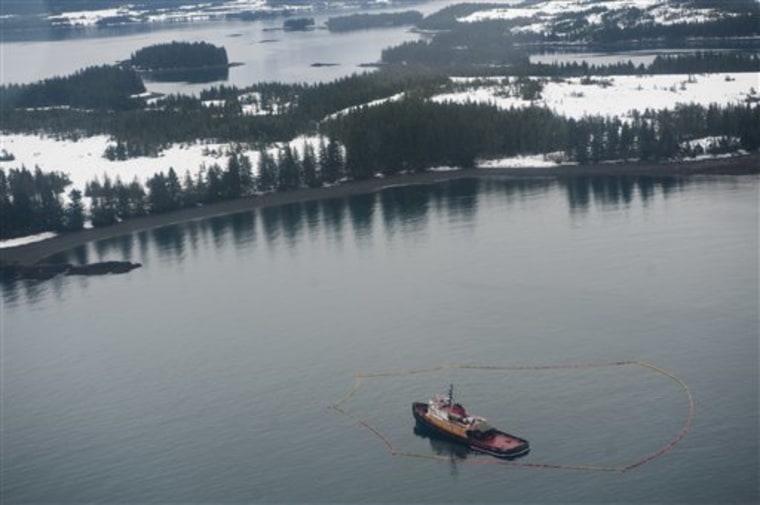A mile-long diesel sheen spread across Alaska's Prince William Sound on Friday where a tugboat had run aground near the site of the 1989 Exxon Valdez disaster, the Coast Guard said.
Officials had hoped to remove the fuel from the tugboat's tanks early Friday before towing it back to Valdez, but diesel removal was halted after about 10 minutes when workers noticed a new sheen on the surface of the water, said Coast Guard Lt. Erin Christensen, a spokeswoman for the joint information center.
Helicopter flights measured the sheen at 50 feet wide by one mile long, Christensen said.
The 136-foot tug Pathfinder had just finished checking for dangerous ice and was heading back to port in Valdez when it hit Bligh Reef at 6:15 p.m. Wednesday.
The boat is part of the Ship Escort Response Vessel System, which was created after the Exxon Valdez ran aground in 1989 and spilled nearly 11 million gallons of crude oil — the worst U.S. spill ever.
Six fishing vessels plus Coast Guard cutters and salvage vehicles worked to skim the diesel off the surface of the water as the tugboat's operator, Crowley Maritime Services, made plans to make another attempt to pump the diesel out Friday afternoon, she said.
Once the diesel has been removed, the tugboat can be towed back to Valdez by Titan Marine, a salvage company that was also helping skim the sheen off Prince William Sound.
Christensen could not estimate how long the diesel recovery operation would take, but the tank pumping has been estimated to take eight hours.
"They no longer see a diesel sheen east of Glacier Island. There have also been no reports of impacts to wild life in that area," Christensen said.
U.S. Sen. Mark Begich of Alaska said it was troubling that a spill response vessel "managed to run aground on one of the most well-marked and well-known reefs in the Northern Hemisphere."
It wasn't immediately known how much spilled. The Coast Guard said Thursday that two of its tanks — containing an estimated 33,500 gallons of diesel fuel — were damaged.
Christensen said an estimate on how much fuel spilled couldn't be done until the fuel was off-loaded to a barge.
A dive team inspecting the Crowley Marine Services tug found damage to the hull and a 4-to-5 foot section of keel missing, said Coast Guard Petty Officer Jon-Paul Rios.
The SERVS system provides two escort tugboats for each tanker traveling through the sound after leaving the Valdez Marine Terminal with North Slope crude delivered through the trans-Alaska pipeline.
Two tankers scheduled to depart the marine terminal when the accident occurred. One tanker was on its way and the other was soon to be, said Alyeska Pipeline Service Co. spokeswoman Michelle Egan. "We are assisting in the response."
Officials are investigating the cause of the grounding. The six crews members tested negative for alcohol use.
Rios stressed that the grounding of the tug was very different from the Exxon Valdez accident in which an enormous amount of black crude oil spilled.
The tug is carrying much lighter diesel fuel that will evaporate in time, Rios said.
